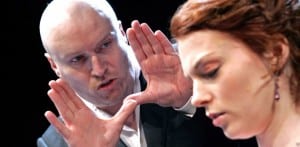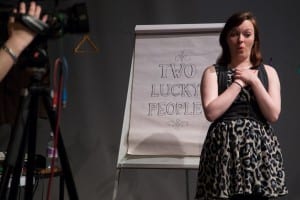
I have always loved the work of Mark Ravenhill, his plays create unique worlds and impossible situations that somehow have more to say about the way we live than simple mimetic drama. His play Product (2005) is a good example, it would seem to be a very clever and thoroughly human story of love, loss and ultimately extremism and revenge. Ravenhill chooses to tell this story to his audience as though it is a pitch to a movie studio, the inherent contradiction between the pure monetarism of the pitch format and the extremely sad story adds a comparison to the drama and asks the audience, perhaps for the first time, whether the religious extremism of the protagonist is in fact a direct reaction to the to the equally extreme capitalism of western society. It is able to at once be deeply human and extremely political.
This might seem like very strange example and certainly there is world of difference between Ravenhill’s play and Three Words. But Product is my favourite example of a technique in writing that I have used frequently when creating Three Words in order to create a dialogue between different elements of each scene. This is what David Edgar has called action and setting in is excellent book How Plays work, the action is the main narrative of the scene and the setting is all the surroundings, the location, company or situation (Edgar, 2009). In Product the setting is the movie pitch and the action is the story of love, tragedy and revenge.
The contrast between the two can be very fruitful to create drama and to build in new layers of subtext. Some scenes will obviously match setting and action together, the scene in Ravenhill’s Shopping and Fucking in which the character Mark is briefly re-united with his flatmates happens, as you would expect, in their flat. In the same play however, when Lulu finds out that that Robbie has given away all the ecstasy she was tasked with selling, she rages at him and eventually assaults him the whole scene is made all the more absurd by their being in a hospital waiting room.

I have attempted in several scenes to play with a contradiction in setting and action, in one scene (picture above) we plan a wedding for two audience members but we do it as if it were a a bank heist, complete with codenames, specialists, and even floor plan of the venue. Here the action of planning the wedding in contrast with the setting of heist planning served firstly to enforce the absurdity of the whole situation. It also reflected exactly how some people felt about weddings that the planning very quickly gets out of their hands and they are forced to please everyone other than themselves, represented here by the extremely pushy cast of calligraphy, catering and fashion specialists and the wedding obsessed psycho.
Here the style of writing is commenting on the content just as it does in Ravenhill’s Product, scenes are structured differently because they represent different things, so that scenes about the chaos and confusion of early relationships are contrasted with the scenes that are told from an older perspective and are about how couples grow together and build their own joint story. Each scene is structured to reflect the stage of the relationship it is to create a dialogue between setting and action, Ravenhill used this technique to draw parallels and ask the audience question. We use the same technique to summon sensations from the audience’s memories and imagination and bring them into the stores we created.
Works Cited
Edgar, D. (2009) How Plays Work. London: How Plays Work.
Ravenhill, M (2008) Plays: 2. London: Methuen Drama.